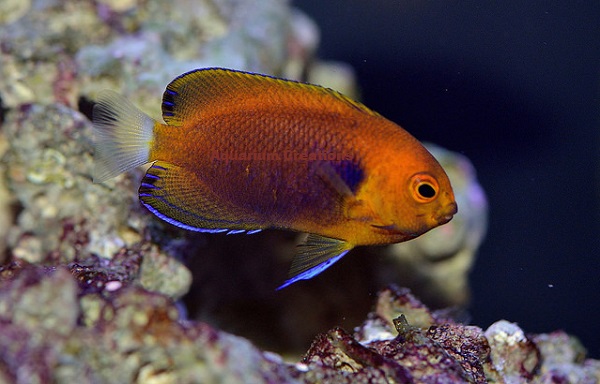Identification:
The Centropyge fisheri is also referred to as the Fisher's Angelfish, Fisher's Pygmy, Fisher's Dwarf Angelfish, Orange Angelfish, or Yellowtail Angelfish. Its found exclusively in the Hawaii Islands and the Johnston Atoll. They mostly have an orange-tan body color with a thin bright electric-blue edging highlighting the lower belly and anal fins, while the caudal fin is a subdued yellow. Like all Pygmy Angelfish, they can be aggressive & completely intolerant of their own species or any other fish of similar color or shape. It's interesting to note that the pygmy Angelfish in the Centropyge genus are among the hardiest angels in the entire Angelfish family. The requirements here are important for your Fisher's Angelfish health. You must have a mature tank that is a minimum of 50 gallons with plenty of live rock and algae growth. The Centropyge fisheri starts out as a shy fish that requires lots of hiding places in a rocky Aqua-scaped aquarium with lots of caves/crevices and ample amounts of live rock for grazing on microalgae and diatoms. Place the rock work with multiple places to hide so they will feel secure enough to come out often. This will provide security, and the more secure it feels, the more it will come out into the open.
Food and Diet:
Dwarf Angelfish are omnivore's. In the wild it feeds primarily on algae, but it will also ingest tiny animals living in the algae. In captivity their diet will be mostly algae, but also offer some other proteins. Feeding them a variety of good foods is important. Offer various types of fresh and dried marine algae, spirulina enriched foods, mysis shrimp, shaved shrimp and other high-quality meaty foods, angelfish preparations, and flakes or pellets designed for algae eating fish. There are several good commercial foods available including Formula II and Angel Formula. Feed several times a day even if natural foods are present.
Recommended amount of drip acclimation time:
3+ hours
Approximate Purchase Size:
Small: 3/4 inch to 1 inch, Medium: 1 inch to 2 inch, Large: 2 inch to 3 inch
|




